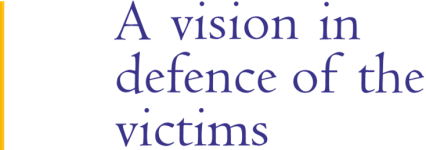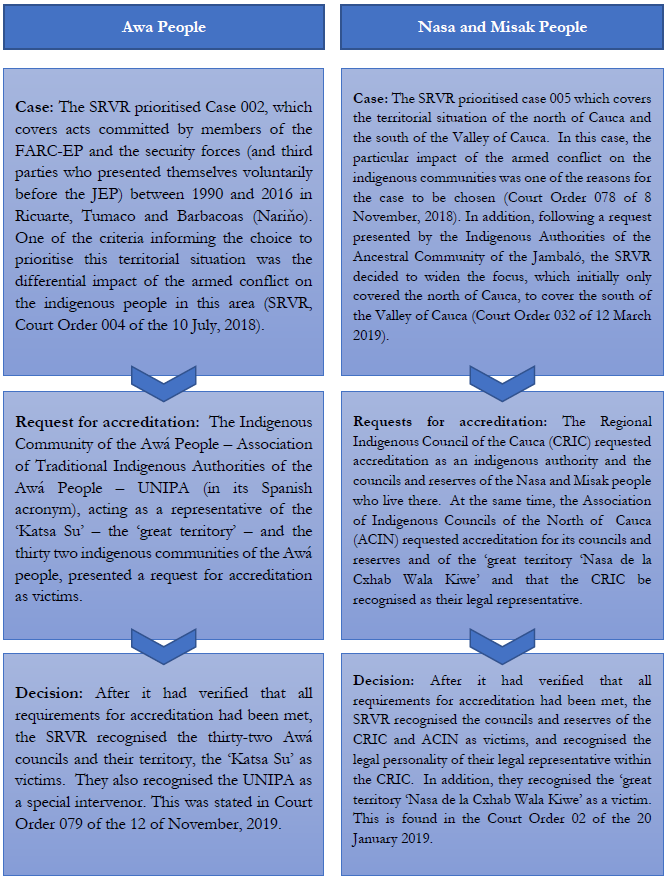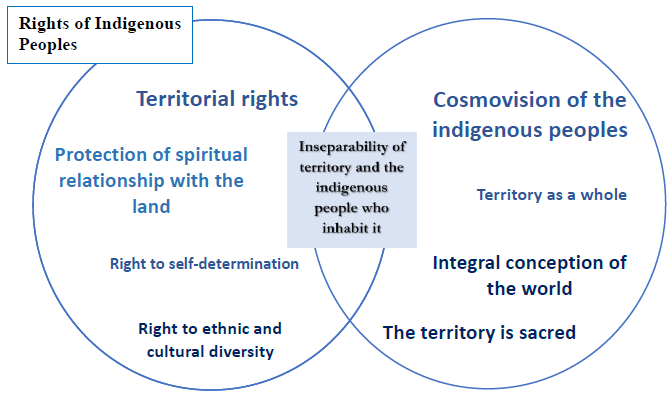
This newsletter focuses on the recognition of indigenous peoples' territories as victims in proceedings before the Judicial Panel for Acknowledgement of Truth and Responsibility and Determination of Facts and Conducts (SRVR). To that end, it analyses Orders 079 of 12 November 2019 and 02 of 17 January 2020 of the SRVR, which recognizes the territories of the requesting indigenous peoples as victims.
 Newsletter No 8. Observatory on the SJP
Newsletter No 8. Observatory on the SJPNewsletter # 8. The recognition of indigenous peoples’ territories as victims
This newsletter focuses on the recognition of indigenous peoples' territories as victims in proceedings before the Judicial Panel for Acknowledgement of Truth and Responsibility and Determination of Facts and Conducts (SRVR). To that end, it analyses Orders 079 of 12 November 2019 and 02 of 17 January 2020 of the SRVR, which recognizes the territories of the requesting indigenous peoples as victims.
| Indigenous communities and the authorities of minority ethnic groups may be recognized as special interveners before the Judicial Panel for Acknowledgement. |
Victims of acts committed in the context of the armed conflict by the FARC-EP, the security forces and third parties or civilian authorities who are not members of the security forces, and who voluntarily submitted to the Special Jurisdiction for Peace (SJP) have the right to request accreditation in the cases or situations prioritized by the SRVR. Upon accreditation, victims are constituted as special interveners in the proceedings before the Chamber and may participate in them (on opportunities for victims' participation before the SRVR, see Newsletter 6). To apply for accreditation, victims must meet the following requirements, established in article 3 of Law 1922 of 2018:
As explained in Newsletter # 7, indigenous peoples and the authorities of minority ethnic groups may be special intervenors before the Judicial Panel for Acknowledgement:
Indigenous peoples have submitted applications for accreditation to the Judicial Panel for Acknowledgement, in line with the process outlined above. The table below summarizes the applications submitted by the Awá people[1] and the Nasa [2] and Misak[3] peoples, who also requested that the Judicial Panel accredit their territory as a victim.
Table 1. Requests for accreditation of the Awá people and the Nasa and Misak peoples

(Account drawn from the SRVR Court Orders 079 of 2019 and 02 of 2020).
As noted in the table, in both cases the Judicial Panel for Acknowledgement not only recognized the territories and councils as victims and the indigenous authorities as special intervenors, but also recognized the territories of these peoples as victims, as they had requested.
The decisions to recognize the territories of these indigenous people as victims of the armed conflict in the proceedings before the Judicial Panel for Acknowledgement are based on the recognition of the inseparability of the territory and the indigenous people who inhabit it. This recognition comes from the SRVR systematically interpreting the national and international legal norms on the protection of the rights of indigenous peoples and their own government, in line with their world view.
Graph 1. Inseparability of territory and the indigenous people who inhabit it: systematic interpretation of the rights of indigenous peoples in line with their world view of territory

(Account drawn from Cars 079 of 2019 and 02 of 2020)
This means that the SRVR systematically interpreted two elements:
There is a comprehensive legal framework that protects indigenous peoples' rights to territory, autonomy, self-determination, ethnic and cultural diversity, among others. The following are some of the elements of the normative framework related to the rights of indigenous peoples, that provided the basis for the Judicial Panel for Acknowledgement to recognize territory as a victim in the above-mentioned cases:
The SRVR recognizes that each indigenous people has its own cosmovision and that, from that cosmovision, it can understand its relationship with the territory in a particular way. Thus, in the case of the Awá people, the SRVR takes into consideration the way in which they understand the territory and their relationship with it, in accordance with the provisions of its ‘Safeguard Plan’, derived from the 2009 Order 004, which states
“The understanding of the territory within our Awá culture reflects how within our cosmovision, an integral conception of the world persists (...) The territory is a whole, the entire land that includes forest, river, stream, people, everything (...) that when we speak of territory the indigenous Awá is referring to a set of fundamental collective and individual rights that must be respected and promoted, something western society does not register with any clarity”. (‘Safeguard Plan of the Awá People’, cited by the SRVR, Court Order 079 of 12 November 2019)
Likewise, in the case of the application presented by ACIN, the SRVR takes into account the way in which the relevant town councils and reserves understand the territory and the injuries it has suffered in defense of its autonomy:
“For indigenous peoples and especially for the Nasa, Uma Kiwe (territory) is considered to be a living being and that it is integral to being a Nasa person, she feels, she must be fed and cared for. To do this, offerings of seeds of the SAHAKELU are made (hence its sacred character).
Our ancestral and sacred territory has suffered violations, disturbances, mutilations, occupations and damage as a result of the internal armed conflict that had a negative impact on the bond that the indigenous communities had with their territory; violating the balance, harmony and autonomy of the Nasa indigenous people of Northern Cauca”. (Request for accreditation of ACIN, cited by the SRVR, Court Order 02 of January 20, 2020).
| Indigenous peoples cannot be fully recognized without their territories.
|
Thus, based on the analysis of the legal framework that protects the rights of indigenous peoples and their relationship with the territory, together with the world views of the applicant indigenous peoples about their territories, the Judicial Panel for Acknowledgement concludes that the recognition of these peoples must include the recognition of their territories. And, therefore, it accredits both the indigenous peoples and their territories as victims.
The decisions of the Judicial Panel to recognize the territories of indigenous peoples as victims, appealing to their worldview and respect for their rights, are very important. On the one hand, they show a serious commitment by the Special Jurisdiction for Peace to apply a lens in its proceedings that is in sympathy with ethnic minorities concerns. On the other hand, it involves the application of the constitutional principles of pluralism and respect for ethnic and cultural diversity on proceedings, as well as the establishment of a relevant precedent for the construction of dialogue in other jurisdictions about the protection of indigenous territories.
However, the recognition of the territory as a victim in the process of accreditation of indigenous peoples is only the first step towards their participation in the proceedings before the SRVR. The Judicial Panel has the task of continuing to use this approach in its proceedings, guaranteeing the effective participation of indigenous peoples in the various proceedings and seeking recognition of the differentiated impacts they suffered in the context of the armed conflict.
[1] The Awa indigenous people live in Colombia and Ecuador. In Colombia, they are located in the departments of Nariño and Putumayo. For more information about the Awá people, please consult the website of the National Indigenous Organization of Colombia (ONIC).
[2] The Nasa indigenous people live in Colombia, in the departments of Cauca, Huila, Tolima, Valle del Cauca and Putumayo. For more information about the Nasa people, please consult the website of the National Indigenous Organization of Colombia (ONIC) here.
[3] The Misak indigenous people live in Colombia, in the departments of Cauca and Huila. For more information about the Misak people, please consult the website of the National Indigenous Organization of Colombia (ONIC).